Where East Met West
Historic Dude Ranching in the Greater Yellowstone Area...
Defined by rugged, forested canyons, lush mountain valleys, and eye-popping scenic vistas, the almost mythical high country surrounding Yellowstone National Park has long been associated with ranching and tourism. Each, in its own way, has been a cultural mainstay, helping to define life in Montana for generations. But when combined with the long-popular enterprise known as dude ranching, these quintessential western industries transcended mere economics to play an historically significant role in perpetuating America’s continuing romance with the Big Sky Country.
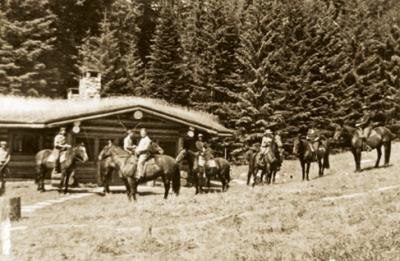
* * * Sufficient change had occurred in American life by the 1890s to transform previously held attitudes regarding the “uncivilized wilderness.” The natural world that hardy pioneers once saw as a threatening obstacle to the nation’s manifest destiny was increasingly replaced by a growing nostalgia for a rapidly disappearing Old West frontier. Rampant urbanization and industrialization in the East confirmed America’s changing character, inspiring various movements to save or recapture what was left of this important part of American heritage and culture.
Once Americans had tamed the forest and subdued its native inhabitants, Roderick Nash noted, “The average citizen could approach wilderness with the viewpoint of the vacationer rather than the conqueror.”
Those who could afford it sought ways of temporarily embracing the wilderness, while still enjoying the comforts of modern life. The resulting “back to nature” movement expressed itself in a variety of ways. In urban areas, the city park movement and countless country clubs flourished, while in the countryside, vacation getaways, such as summer camps and National Parks, proliferated across the American landscape. Popular organizations, such as the Sierra Club and the Boy Scouts emerged as part of a widespread conservation crusade. Meanwhile, bestsellers such as Jack London’s Call of the Wild and Edgar Rice Burroughs’s Tarzan of the Apes series spoke to the idealized and romanticized place that the wilderness occupied in the American mind.
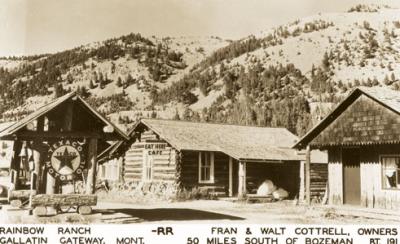
In the Mountain West, these widespread trends not only fostered the celebration of nationally known tourist destinations like Yellowstone National Park, but also promoted the corresponding development of dude ranching. Dude ranches sought, as correspondent Mary Roberts Reinhart put it, to satisfy the “hunger of the civilized to get away from civilization and yet avoid the hardships few of us can easily endure.” To this end, they grafted eastern ideals on western culture in a profitable, yet historically and environmentally oriented manner. Unlike extractive industries, such as mining and logging, dude ranching prioritized the importance of rugged scenery, wild game, western nostalgia, and the ongoing preservation of all three.
Understandably, Yellowstone National Park and the dude ranch industry had a symbiotic relationship during the early 20th century. The Dude Ranch Association, for example, cultivated close ties with Park management, in hopes that both interests could profit from collaborative promotional efforts. “The dude ranchers as well as Yellowstone Park wish to sell the West to the East,” Guy Edwards, Assistant Superintendent of Yellowstone, noted at an annual gathering of the Dude Ranch Association; “our common purpose is to tell them about this great Northwest.”
Between 1900 and 1930, rail and automotive connections with Yellowstone multiplied and the number of visitors mushroomed from 18,000 to 260,000 annually. A plethora of new facilities tried to address this increased demand within Park boundaries, but it was clear that additional accommodations within close proximity to Yellowstone were critically needed. Aiming to meeting this demand, westerners converted dozens of working cattle ranches and homesteads to seasonal guest facilities and, almost overnight, Yellowstone became the center of a burgeoning dude ranch industry.
The “father of dude ranching in Montana” was James “Dick” Randall, an Iowa native who traveled west to Montana Territory in 1884 when he was just 18. Like many of his contemporaries, Randall’s first career was that of a cowboy, but when the terrible winter of 1886-87 decimated the great herds that once roamed the open range, he was forced to look elsewhere for employment. For nearly a decade Randall worked as a stagecoach driver and hunting guide, eventually purchasing land near Corwin Springs, Montana, some ten miles north of Yellowstone National Park.
There, Randall built the famous OTO Ranch, ostensibly as a base camp for his popular hunting trips. As word of Randall’s enterprise trickled back East, tents were replaced by log cabins. He soon acquired dairy cattle and planted gardens to feed the growing numbers who traveled via the Northern Pacific Railroad to his wilderness getaway. When World War I started in Europe, and German submarine warfare discouraged overseas travel, Randall constructed a grand central lodge that featured kitchen and dining facilities, recreation and trophy rooms, and 10 guest rooms.
The extended expedition into Yellowstone Park was the hallmark of vacations at the OTO. In 1926, for example, Randall organized what was likely the largest pack trip in the history of dude ranching, when he led 368 members of the Sierra Club from San Francisco on a multi-day trek through America’s Wonderland. Randall’s successful operation set the standard for similar venues throughout the region in the decades that followed.
The beautiful Gallatin Canyon south of Bozeman, Montana, was another locus of early dude ranching activity in the Greater Yellowstone Ecosystem. Initially, it was only the occasional rancher who followed in Randall’s footsteps and periodically domiciled guests. In 1906, however, Tom Michener’s Camp, Pete Karst’s Cold Spring Resort, and Sam Wilson’s Buffalo Horn Resort fixed their rates for room, board, and saddle horses at $18 a week. Together they cooperated with hopes of attracting a lucrative clientele.
Dude ranching was off to a successful start in the Gallatin Canyon by 1909, when Karst’s Resort took in 183 visitors, but that was only the beginning. The following year, the Milwaukee Road connected with Salesville (now Gallatin Gateway) just north of the canyon, and began promoting “Gallatin Way” to the Park as an alternative to the Northern Pacific Railroad for the Yellowstone tourist trade. Responding positively to these developments, the number of tourists visiting Karst’s Resort jumped dramatically to an impressive 600 guests in 1910.
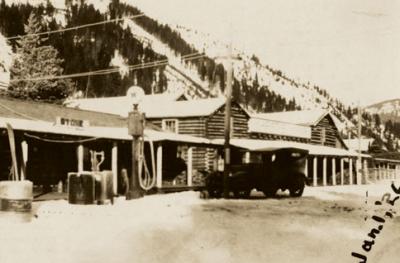
Karst’s success persuaded other Gallatin Canyon ranchers to follow suit. One such operation was Cunningham and Behring’s Nine Quarter Circle Ranch, which first offered guest cabins in 1910 for the exclusive use of Chicago paper baron F. O. Butler and his family. The Butler’s soon circulated a brochure in the Chicago area and, in the years that followed, they invited a large circle of friends to the Nine Quarter Circle.
Other guests continued to arrive in the Gallatin Canyon area. By the time the holocaust in Europe ended in 1918, many Americans were permanently “sold” on dude ranching in the Greater Yellowstone Ecosystem.
Despite these early examples, the “golden age” of American dude ranching did not begin in earnest until the 1920s, when an unprecedented number of working ranches began accepting guests to offset losses caused by a prevailing agricultural depression. This was especially true in the Gallatin Canyon vicinity where, during the late 19-teens and early 1920s, Sam Wilson’s operation became the well-known 320 Ranch. Other dude ranches that opened for business during the period included the Elkhorn Ranch and the Rising Sun Ranch on Sage Creek; the Rainbow Ranch above the Lower Basin; Buck’s T-Four in the Lower Basin; and the B-K Ranch, now known as the Lone Mountain Ranch, along the West Fork drainage.
“Dude ranching is now coming into its own as one of the West’s fast developing industries,” wrote W. B. Banfill in 1927. In Montana, no less than 150 dude ranches offered “the most typically western vacation.” The vast majority of these, according to a Montana Department of Agriculture, Labor, and Industry Report, were “located in the valleys north of Yellowstone Park, in or near the Beartooth, Absaroka, and Gallatin National Forests . . .”
As the full weight of the Great Depression decended upon the nation, however, times hardened for the vacation industry. National park tourism and dude ranch visitations initially declined as much as 38 percent. By the mid-1930s, as the troubling rise of fascism in Europe again discouraged overseas travel, western dude ranchers received a much-needed shot in the arm. At the Depression’s close, when writers for the Works Progress Administration compiled a listing of dude ranches in Montana, no less than nineteen were located in Gallatin County.
Although many of the dude ranches of the Greater Yellowstone Ecosystem survived the Great Depression, the advent of World War II presented an equally challenging set of circumstances. Labor shortages, food rationing, and a pervasive lack of interest in travel during wartime made successful dude ranching especially difficult. Complicating these impediments, the Office of Defense Transportation eliminated rail and airline travel advertising, the medium through which dude ranching was brought before the public. Summing up the less than desirable situation his industry faced, Dude Ranch Association President I. H. Larom concluded “Forty to 50 percent of normal is as good a guess as any for most outfits this season.”
By the summer of 1944, however, America’s military success overseas was becoming increasingly apparent, and dude operators could see the light at the end of the tunnel. The post-war years brought the greatest era of prosperity in our nation’s history, the baby boom, the interstate highway system, and the emergence of a family-centered vacation industry of unprecedented proportions. Aided by these simultaneous developments, and with the Greater Yellowstone Ecosystem as a nucleus, dude ranching emerged as “the single most unique contribution of the Rocky Mountain West to the ever-growing national vacation industry,” according to historian Lawrence Borne.
Today, like a century ago, Montana’s guest ranches, hunting camps, and fly fishing lodges remain uncommon and exceedingly popular vacation venues that afford their visitors an opportunity to seek respite from their hectic modern lives, while reconnecting with the wilderness landscapes of our nation’s past. Here, in the vast, scenic, and still rugged landscapes between Yellowstone and Glacier National Parks, one can still return to a more simple time where the western mystique continues to redefine itself.
~ Derek Strahn, historic preservation consultant and writer, teaches history at Bozeman High School. He was principal historian on the recently approved Butte-Anaconda National Historic Landmark District nomination. He can be reached at [email protected].



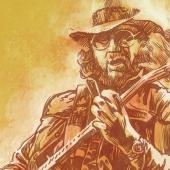



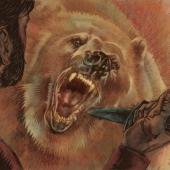

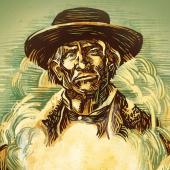
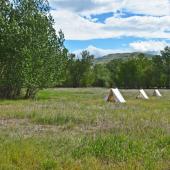
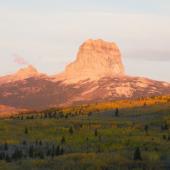
Leave a Comment Here